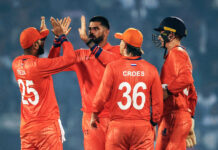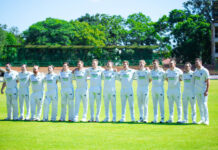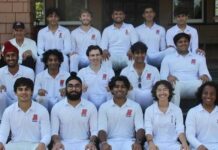The general meeting of the KNCB, the governing body for Dutch cricket, which takes place next week, will face some critical choices about the organisation’s structure, perhaps the most far-reaching since the decision to join the ICC back in 1966.
Some might argue that the pass was already sold a couple of years ago, when a special general meeting agreed to establish a separate entity, a limited liability company called Cricket Nederland BV, to run its future major events, starting with the home ODI series against Full Members which form part of the Super League.
The KNCB Board took the view that this separation of powers was desirable to isolate the financial risks associated with such events, and reassured the clubs that any profits would flow back into the coffers of the Bond.
But at that point the KNCB’s member clubs were able to ensure that oversight of the BV’s operations would be entrusted to a Raad van Commissarissen (Supervisory Council), its members largely elected by the general meeting and reporting back annually to the member clubs, while the CEO of the KNCB was also CEO of the BV.
There was, however, a problem: the BV promptly appointed KNCB chair Betty Timmer as its Events Manager, so that the then CEO, Jaap Wals, was both responsible to Ms. Timmer in her capacity as chair, and her line manager in her role as employee of the BV.
This was, to say the least, untidy, and Ms Timmer assured the general meeting last December that the issue would be resolved by the next meeting in April.
The Board had already appointed a Governance Review Committee led by former KNCB chair René van Ierschot to consider the future relationship between the Bond and the BV, and this committee’s report and the Board’s proposals arising from it are due to be considered at next week’s general meeting.
The committee made, in essence, three recommendations:
• that all international operations, including the men’s and women’s national teams, players’ and technical staff contracts, and the national youth selections be brought under the BV;
• that the BV have its own CEO, of separate and equal status with the CEO of the KNCB; and
• that the oversight function currently in the hands of the Supervisory Council be transferred to the KNCB Board.
The Board has not taken up the first recommendation, which would have placed the lion’s share of the KNCB’s ICC funding, currently running at over €2 million a year, in the hands of the BV, and would have made the split virtually absolute, reducing the governing body’s role to what the committee describes as its ‘core business’: promoting participation and organising domestic competitions.
But it is proposing both the appointment of a separate CEO for the BV and the abolition of the Supervisory Council.
You might be forgiven for asking why the Dutch, alone in the international cricket world, see it as necessary to follow this route, when everywhere else the direction of major events remains under the responsibility of the governing body’s CEO.
According to rumour, some clubs at least are seriously concerned about these developments, and it seems highly probable that the committee’s report and the Board’s proposals are in for some lively discussion next week.
The structural proposal for two separate CEOs is in itself likely to be controversial, and the abolition of the Supervisory Council scarcely less so.
Steven van Hoogstraten, chairman of the Supervisory Council and another former chair of the KNCB – as well as being a lawyer with extensive experience in the direction of government departments – indicated last week that he believed the role of the Council was an important one.
‘We have a well-formulated place in the Statutes [of the BV],’ he observed, ‘and our work is to follow with an open and critical mind what is done or planned by the manager, and to have a watchful eye for financial risks.
‘We consider our work in the interest of the Dutch cricket community as a whole.’
While refraining from comment on the constitutional issues raised by the working party’s recommendations and the KNCB Board’s proposals, Van Hoogstraten did make clear that his Council was surprised that it had not been consulted.
‘And we do not understand,’ he added, ‘why this “governance” change is better than what we have at present.’
The clubs’ dissatisfaction appears also to stem from Ms. Timmer’s position in the proposed changes.
Explaining her decision to step down as KNCB chair, a memorandum from the Board states that ‘Ms Timmer gives her preference to her function within Cricket Nederland BV’, giving rise to concern that the Board may be intending to appoint her to the CEO role without a formal application process.
This would contrast strongly with the appointment of the KNCB’s new CEO, Milena van Not, where there was an exhaustive process of selection.
There is a great irony here: one of the reasons that the clubs elected Ms Timmer as chair of the KNCB in December 2015, along with her slate of candidates for the Board (of which, in the interests of full disclosure, we must state that the present writer was a member), in the first contested election in KNCB history, was their strong disapproval of the way in which the previous Board had appointed the then CEO, which was without any formal application or selection process.
It would be strange indeed were the clubs’ fears to be confirmed and something very similar were to happen with the appointment of a CEO to the BV.
You’re reading Emerging Cricket — brought to you by a passionate group of volunteers with a vision for cricket to be a truly global sport, and a mission to inspire passion to grow the game.
Be sure to check out our homepage for all the latest news, please subscribe for regular updates, and follow EC on Twitter, Facebook, LinkedIn and YouTube.
Don’t know where to start? Check out our features list, country profiles, and subscribe to our podcast.
Support us from US$2 a month — and get exclusive benefits, by becoming an EC Patron.







